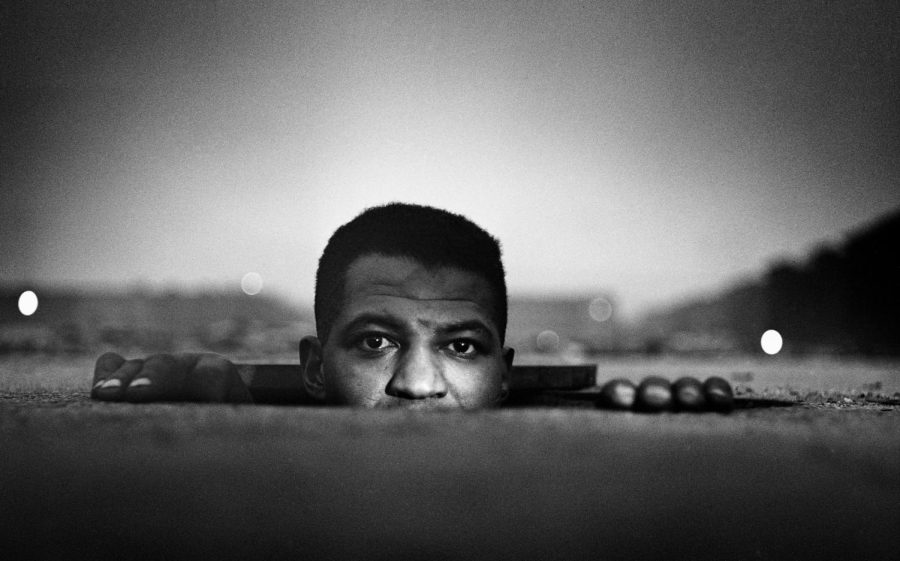A Moment Captured
Gordon Parks uses his camera as a weapon against injustice
“A Loaded Camera: Gordon Parks” features the work of African-American photojournalist Gordon Parks and showcases his groundbreaking impact on American history. As a self-taught photographer, Parks highlighted the everyday lives of Black people and broke socioeconomic barriers surrounding him.
As a tribute to his work, Elizabeth Mitchell, the co-director at the Cantor Arts Center in Palo Alto, curated a three-part collection of his photographs, with the last part on view until July 3, 2022. Mitchell began the process of curating the exhibition to showcase Parks’s story-telling ability.
“Parks was so incredibly talented at focusing on just a few people and using those human figures in their setting…to tell a story, just in one photograph,” Mitchell said.
Parks focused his work during the 1950s and 60s and documented the stories of the people he encountered. He photographed oppressed people throughout the Civil Rights era and during times of social unrest.
“He took a lot of, at the time, really challenging images and showed Black Americans living as they absolutely live,” Mitchell said.
In the 1950s and 60s, it was unusual to photograph people in disadvantaged situations, especially when these photos were taken by a Black photographer. Parks represented a shift in American society as a Black photographer documenting Black experiences in a world primarily photographed by white photographers. Ultimately, Parks felt it was his mission to show the truth of America.
“He showed economic, very real circumstances around him that showed how institutionalized racism was, and is in America,” Mitchell said.
One particular image that captures the ‘realness’ of Parks’s photographs is his portrayal of “A Harlem Family 1967.” Parks lived in a poverty-stricken family’s tenement and took portraits of their daily life.
“To get those stories, you build trust, and you walk in someone else’s shoes,” Mitchell said. “You don’t just read about it and experience it at a distance, you have to really be there.”
When “A Harlem Family 1967” was published, the audience response was immediate — with monetary support.
Even today, Park’s authentic and important work has continued to have a positive, emotional effect on people. Jade Minskoff, a Paly junior and AP Art History student, visited the exhibit with her class on a field trip.
“There’s a lot of consistency. It’s like there’s realness in it. There’s emotion. It’s raw. It’s how life is and he really goes out of his way to portray that,” Minskoff said.
After attending the exhibit, Minskoff found a deeper appreciation for photography as a whole. Parks’s photos helped her realize the significance of capturing an entire narrative into a single shot.
“Realizing that there’s an ability to show so much emotion and so much context from just one photo made me appreciate photos even more,” Minskoff said.
The exhibit helped Minskoff acknowledge the importance of imperfections in art to show a genuine story.
“In our society, we’ve been conditioned to think that a photo is supposed to be perfect,” Minskoff said. “I want to see the realness and the beauty and actually how life is.”
Parks’s photos illuminate a discussion of racism and inequality in America, a topic that is still relevant today.
“It’s good to remember that there were people photographing this and the circumstances around this decades ago,” Mitchell said. “We’ve been having these conversations and finding these things out for a very long time.”
Parks’s work continues to influence modern-day views of prejudice and racism, and change perceptions around the art of photography. The impact Parks leaves behind creates an eye-opening view of our country and society for all who experience his art.
“It’s often said that Gordon Parks showed America Black America,” Mitchell said. “But I think it’s more accurate to say he showed America to America.”
Virtual Tour
Oops! It seems like this post isn't published yet. Stay tuned for updates!Featured Photo courtesy of Gordon Parks Foundation
Print Issue
Please click on the three vertical dots on the top right-hand corner, then select “Two page view.”

2020-2021 - Staff Writer
2021-2022 - Staff Writer
2022-2023 - Managing Editor
I joined C Mag because of the focus on arts and representing our...

2020-2021 - Staff Writer
2021-2022 - Staff Writer
2022-2023 - Social Media Manager
I joined C mag to meet people. My favorite part of C mag is...







